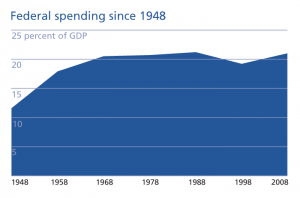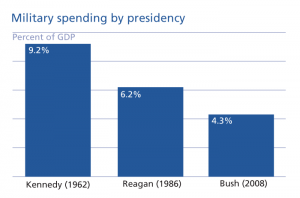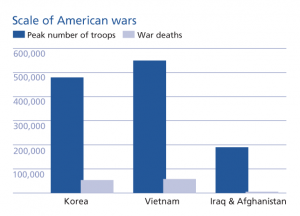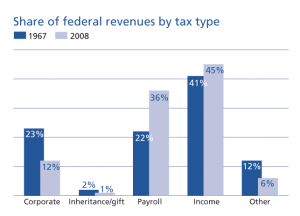The Roots of American Decline
The United States, we are told ever more frequently and emphatically, is heading toward fiscal disaster, unable to simultaneously pay for its extensive military involvements around the world, its current commitments to social programs, and the investments in education, infrastructure, and research needed to compete with China and other rivals.
If current trends continue, American economic and military dominance will be lost, the era of American empire over. Whether the U.S. will be succeeded by a new hegemon or the world will enter an era of multiple power centers is as yet uncertain.
What is the cause of the fiscal crisis at the root of American decline and how can it be solved?
The dominant view, shared by almost all those on the right and many “centrists,” is that fiscal crisis is due to rising spending on social programs. (An alternative version of this theory points to increases in military spending for the Iraq and Afghanistan wars.) From this perspective, excessive spending produces fiscal crisis which, in turn, causes decline. The solution, then, is to cut back social benefits (or military commitments) in order to head off a run on the U.S. dollar and drastic increases in interest rates that would fatally weaken the U.S. economy.
 This approach doesn’t square with basic facts about American state spending. The federal budget in the U.S. has held steady as a share of GDP since 1968 (see below). That lack of growth is possible in part because social benefits in the U.S. are among the skimpiest of any industrialized country, according to the Organization for Economic Co-operation and Development (OECD), a group of the thirty-three richest countries. The OECD also reports that poverty rates are higher in the U.S. than most other rich countries. The last expansion of Federal social programs occurred with the Great Society of the 1960s. And military spending, again as a percentage of GDP, has actually declined drastically since the Cold War (see below).
This approach doesn’t square with basic facts about American state spending. The federal budget in the U.S. has held steady as a share of GDP since 1968 (see below). That lack of growth is possible in part because social benefits in the U.S. are among the skimpiest of any industrialized country, according to the Organization for Economic Co-operation and Development (OECD), a group of the thirty-three richest countries. The OECD also reports that poverty rates are higher in the U.S. than most other rich countries. The last expansion of Federal social programs occurred with the Great Society of the 1960s. And military spending, again as a percentage of GDP, has actually declined drastically since the Cold War (see below).
 If neither military nor overall spending are increasing burdens on the U.S. economy, then they cannot account for U.S. decline. Instead, I hope to show that the real problem is the misallocation of government revenue and expenditure, resulting in resources being diverted from the tasks vital to maintain economic or geo-political dominance.
If neither military nor overall spending are increasing burdens on the U.S. economy, then they cannot account for U.S. decline. Instead, I hope to show that the real problem is the misallocation of government revenue and expenditure, resulting in resources being diverted from the tasks vital to maintain economic or geo-political dominance.
To understand American economic and geopolitical decline we must identify the elites who determine much of the federal spending and then explain how the transformation of U.S. politics in recent decades has allowed those elites to exert control over governmental resources and agencies. Sociologists, beginning with C. Wright Mills, have found that elites—the heads of large corporate and governmental organizations—exercise disproportionate power in the United States. I have found that conflicts among elites and with non-elites shaped the emergence of capitalism in early modern Europe and, as we will see in the next section, the decline of dominant powers in that era.
Our understanding can be clarified if we compare U.S. dominance and decline with the histories of two previous great powers.
Great Powers, War, and Decline
Just as social spending is incorrectly blamed for the U.S.’s current budgetary woes, military expenses are viewed as the cause of past great powers’ fiscal crises and decline. In his 1987 book, The Rise and Fall of the Great Powers, British historian Paul Kennedy argued that for the most powerful nations, whose interests span the globe, the costs of their military commitments outweigh the benefits of empire. Eventually, “imperial overstretch” saps economic growth as resources are diverted to the costs of empire, and the dominant power’s economy declines until it’s no longer able to afford the military needed to sustain its position. That, in Kennedy’s view, was the cause of each previous great power’s decline—and, he predicted, so it would be for the United States.
In fact, as I’ve previously found, the temporal sequence was the opposite of what Kennedy describes: military defeats and the loss of colonies preceded each hegemon’s fiscal crisis. The Netherlands won its independence and took colonies from Spain when its budget was a fifth of its former ruler’s. The Dutch, in turn lost most of their colonies to Britain while their budget was three times greater. The problem wasn’t the availability of resources: colonies yielded enough revenues to pay for the general costs of fighting wars against other European nations and controlling empires. Rather, European powers lost wars and colonies because they were unable to gain central control over the troops and weapons their budgets bought, or to ensure that colonial profits and domestic taxes actually arrived in the central treasury.
The Netherlands was a coalition of provinces, cities, and chartered companies that defeated Spain when they fought together. The Dutch grabbed colonies on three continents, because Amsterdam and the companies were able to send their own ships and men around the world without getting approval or resources from the provinces that did not share their interests or daring. In so doing, the Dutch became the dominant economic and naval power of the seventeenth century.
However, when the Netherlands needed to mobilize greater resources against the rising British, their fragmentation ensured defeat. Even though the Dutch were richer than the British and had more ships, they were divided into separate navies (seven of them!) that did not fight in unison because they didn’t share the same commercial or geo-strategic interests. Proposals to centralize governmental authority or create a unified military command were blocked by provincial interests, and colonial companies were able to withhold revenues from the national government. While these problems were apparent to Dutch state officials and to outside commentators who formulated reform proposals, their proposals were blocked by provincial elites who retained the capacity to protect their particular interests even at the expense of their nation’s geopolitical and economic dominance.
Britain was alone among the European great powers in creating a government able to prevent particular families or elites from appropriating tax revenues or claiming hereditary rights to offices and military commands. The national parliamentary system forged in the Civil War and institutionalized after the Glorious Revolution allowed the gentry and big London merchants to block each other’s unilateral grabs for office and resources, and it forced those elites to build party coalitions spanning counties and interests. Unable to exit those coalitions by appropriating private privileges, British elites forged agreements that controlled policy and operated the state’s fiscal levers in their collective self-interest. While nobles and gentry dominated the highest ranks in the navy and army, there was promotion from below and incompetent highborn officers were not entrusted with key commands. Britain’s military was reformed in time for the decisive showdown with Napoleon.
The corrupt East India Company and its army had been nationalized in the eighteenth century when self-dealing by corrupt company officials threatened Britain’s economic and military hegemony in Asia. The nineteenth century reform of the civil service maintained Britain’s advantage in state capacity, guaranteeing the nation’s continued fiscal and military dominance over its European rivals. Britain was able to finance its imperial and military costs out of the profits of empire until World War I.
The Military Now
The contemporary American military faces the same problem of divided commands and misallocation of resources that plagued the seventeenth century Dutch (and all the other European powers except Britain). Even as U.S. military spending has fallen as a share of GDP, its advantage over other powers has increased. In 2009, according to data compiled by the Stockholm International Peace Research Institute, the U.S. accounted for 43 percent of total world military spending—more than the next fifteen biggest spenders combined. This margin is far greater than that enjoyed by any of the dominant powers in the past 500 years, and probably ever in world history. At present, though fighting just two wars that by historical standards are small (as seen in the chart on p. 47, the number of U.S. troops in Iraq and Afghanistan combined peaked in 2009 at 190,000, far less than the maximums of 550,000 in Vietnam and 480,000 in Korea) and not particularly bloody (U.S. deaths in the two current wars totaled 5,316 at the end of 2009, less than a tenth of the Vietnam fatalities and a seventh of Korea’s), the American military describes itself as “overextended” and its forces as “tapped out.” How can that be?
 Much of America’s military budget is still spent on weapons systems designed to counter the Soviet Union but now worthless for fighting in Afghanistan, Iraq, or any other area the country might plausibly become involved in. Despite having twice run on a platform of military restructuring (to fight precisely the sorts of wars he initiated), President George W. Bush succeeded in only canceling the Army’s Crusader Artillery system. President Obama cancelled the F-22 fighter jet in his first year. If he attempts to further reorient military spending, the President will meet resistance from all who benefit from current priorities.
Much of America’s military budget is still spent on weapons systems designed to counter the Soviet Union but now worthless for fighting in Afghanistan, Iraq, or any other area the country might plausibly become involved in. Despite having twice run on a platform of military restructuring (to fight precisely the sorts of wars he initiated), President George W. Bush succeeded in only canceling the Army’s Crusader Artillery system. President Obama cancelled the F-22 fighter jet in his first year. If he attempts to further reorient military spending, the President will meet resistance from all who benefit from current priorities.
The misallocation of American military budgets is not mainly caused by the self-dealing of oligarchs who control military spending, as was the case in early modern Europe, although the recent privatization of some military functions is diverting an increasing fraction of the military budget. Rather, I have found that consolidation of the defense industry has allowed interlocking elites (defense contractors, military service heads, and bankers) who have financed industry consolidation to resist the reallocation of spending away from highly profitable though strategically worthless weapons systems. New weapons systems and types of forces proposed by military reformers as appropriate for the actual wars fought by the U.S. today aren’t expensive enough to generate sufficient profits to justify the capital invested in the merged defense firms.
Such institutional interests are embodied in and reinforced by the structure of careers within the U.S. military. Officers are assigned to units that man and deploy specific weapons systems. A naval officer, for example, commands submarines designed to fire nuclear missiles or aircraft carriers built to allow fighter planes to shoot down enemy air forces. A decision to invest in mine sweepers to counter the sort of low-cost and low-tech challenge most likely to be posed by today’s actual enemies would stymie the careers of officers attempting to rise in the resultantly stagnant submarine or carrier corps. And since officers almost never receive further promotions and often have to leave the military if they transfer from one weapons system to another, they’re naturally reluctant to take command of forces devoted to counterinsurgency, civilian administration, or low-tech weapons designed for actual combat.
budget priorities
These days, competition among putative hegemons is mainly economic rather than military—a marked change from at least the past 500 years. Investment in infrastructure, scientific research, and education are paramount, and this is the realm in which China has focused almost all its efforts. In fact, Johns Hopkins sociologist Giovanni Arrighi has argued that China hasn’t even attempted to compete with the U.S. militarily. Unlike previous challenges to dominant powers (like those mounted by Germany and Japan to Britain and the U.S. in the first half of the twentieth century), the Chinese threat comes from economic growth, not military might.
 America’s economic and military competitiveness have been hobbled as elites have gained greater control over civilian spending and taxes to the detriment of the kinds of investment fundamental to long-term economic growth. Federal outlays for “general science, space, and technology” are by far the largest source of the basic scientific research that is essential to compete with rival economic powers, but they fell from 4 percent of the budget and 0.786 percent of GDP in 1967 to 0.93 percent of the budget and 0.21 percent of GDP in 2009. Spending on infrastructure has stagnated as bridges collapse, air and road traffic snarl, and a shrinking network of passenger trains struggle to reach early twentieth-century speeds. From arrival at the airport to the high-speed train or subway trip into town, a visit to most countries in Europe and East Asia can seem to an American like a journey to Tomorrowland, never to be realized in the U.S. outside of Disney World.
America’s economic and military competitiveness have been hobbled as elites have gained greater control over civilian spending and taxes to the detriment of the kinds of investment fundamental to long-term economic growth. Federal outlays for “general science, space, and technology” are by far the largest source of the basic scientific research that is essential to compete with rival economic powers, but they fell from 4 percent of the budget and 0.786 percent of GDP in 1967 to 0.93 percent of the budget and 0.21 percent of GDP in 2009. Spending on infrastructure has stagnated as bridges collapse, air and road traffic snarl, and a shrinking network of passenger trains struggle to reach early twentieth-century speeds. From arrival at the airport to the high-speed train or subway trip into town, a visit to most countries in Europe and East Asia can seem to an American like a journey to Tomorrowland, never to be realized in the U.S. outside of Disney World.
Instead of addressing these needs, our budget is languishing in terms of GDP, and, as documented by non-partisan organizations like the Center on Budget and Policy Priorities, increasing portions are spent on unproductive subsidies to well-connected firms and elites. Current examples include: subsidies, water rights, and access to federal lands for the overproduction of certain agricultural commodities; a commitment to a Medicare drug plan that pays prices significantly higher than anywhere else in the world for drugs developed mainly in federal or university labs (or for copycat drugs designed to extend patents with no medical advantage over older generic drugs); free access to federal lands for mining, ranching, and logging with no obligation to pay for environmental effects which are then borne by public funds and health; and federal tax benefits and direct subsidies for the export of technology and capital to foreign subsidiaries and customers.
The 40-year stability of the federal budget masks a dramatic reallocation of the taxes that support it (see below). Corporate, inheritance, and gift taxes have declined as a share of revenue (from 25 percent in 1967 to 13 percent in 2008). That decline has been made up entirely by increases in Social Security and Medicare payroll taxes. The top income tax rate, which was 75 percent in 1968, is now 35 percent, and President Obama has faced resistance to his modest proposal to return it to the 39.6 percent level of the Clinton years. The top estate tax rate dropped from 77 percent in the 1960s to 45 percent by 2008, and (at least temporarily) to 0 percent in 2010 (and every twenty-first century Republican presidential candidate and virtually every GOP member of Congress has pledged to permanently abolish that tax, which falls only on the wealthiest 2 percent of Americans, and mainly on the richest 0.1 percent.
In this context, it is not surprising that many taxpayers resist further increases to make up for tax cuts for those at the top and instead support politicians who advocate tax cuts for all. Nor is it surprising that the wealthiest seek to maintain the political structures and politicians who have delivered tax cuts and subsidies to them that dwarf those in every other developed nation. What needs explanation is the absence of any significant effort by the state to force elites to coordinate spending in a way that would provide the infrastructure, research, and trained workers needed to compete internationally.
Political Sources of Decline
The shift in spending from programs that further national productivity and competitiveness toward ones that don’t is a consequence of the restructuring of elite relations in the U.S. over the past four decades, This process has been traced most clearly by sociologist Mark Mizruchi, who writes that the U.S. was characterized, until the 1980s, by a dual elite structure. Like the similar structure in imperial Britain, this set up ensured that local and national elites could limit each other’s attempts to appropriate state powers and offices. That, in turn, gave federal officials a high degree of autonomy to appropriate revenues and to implement policies that furthered national military and economic dominance, even at the expense of individual elites.
National banks, linked together by directors who serve on multiple corporate boards coexisted with regional and local banks and firms that were shielded from competition with bigger rivals thanks to federal and state regulations. Local elites had the political muscle to sustain these through influence on their Congressional delegations and in their state governments. Both national and local firms in most industries, then, had enough political power to prevent each other from fully capturing state agencies and from monopolizing markets or governmental resources.
But this structure of elite relations has been transformed in recent decades by waves of mergers in sectors such as banking, telecommunications, media, utilities, retail sales, and agriculture and by the declining capacity of national banks to control firms. Once-dominant banks face competition from new regional behemoths created by the merger of smaller competitors and from non-bank firms freed by federal deregulation to issue their own financial instruments. Competition and the relaxation of federal regulations have led national banks to focus their resources on more lucrative investment banking, further removing them from active involvement in the management of industrial firms.
Mergers have also reduced intra-industry differences over government policy, creating unified voices push legislative changes to enactment. The banking and telecommunications “reform” acts of the 1990s failed to pass Congress in earlier decades due to counter-lobbying by (mainly regional) sectors of those industries with opposed interests. But mergers resolved those disagreements as secondary sectors were brought into larger firms (or merged themselves to form new large firms) and so came to share the most general interest of their industries. Deregulation opened the way to further waves of mergers and acquisitions, intensifying elite consolidation within major industries.
Consolidation within sectors facilitates the capture of government agencies and their powers and budgets by firms: the bigger the firms, and especially the less competition they face within their sectors, the greater the slice of the federal budget they control. The drastic fall in the share of workers in unions and the decline of national membership organizations have weakened the main sources of popular challenges to elite control over government resources and policies.
Future Prospects
As previous great powers faced decline, there were voices in each polity that correctly diagnosed the problem and proposed solutions, which, in retrospect, would have made significant differences. Each had schemes to eliminate tax privileges, end elite control over offices and governmental powers, and reform the military. Voices called for measures to invest in infrastructure and to hold or attract skilled craftsmen and businessmen and their enterprises from foreign competitors. Almost all of those reforms were stillborn. Only in Britain, where single elites or families were limited in their ability to seize and hold pieces of the state, were significant reforms enacted, and that’s why British dominance lasted so much longer than previous hegemons or, it now appears, the United States.
All of President Obama’s proposed (and enacted) reforms—in health care, energy, research funding, infrastructure investment, and financial regulation—are premised on winning support by accommodating elites and firms through continued subsidies and privileges. But such offers have the double effect of deepening the federal government’s fiscal crisis and fostering popular cynicism about the possibilities of genuine reform within the American political system.
Scenarios for significant change are based on hopes that the financial or other crises will foster a sprit of sacrifice among the public at large. However, decline and fiscal crisis are reversed only when elites are forced to surrender privileges. Ralph Nader’s most recent book, Only the Super-Rich Can Save Us! (2009), a utopian novel that imagines billionaires undermining corporate power and revitalizing citizen action, shows how much current progressive plans are based on hopes for elite generosity rather than realistic efforts at political mobilization. It is especially revealing, and depressing, that this book is the latest word from the American who has been the most successful at building citizen organizations over the past forty years. Claims that the Internet might foster effective political movements that can replace defunct or shrunken unions and mass organizations have yet to be realized.
Good ideas and high hopes did not save previous imperiums. There is no historical or social scientific basis for expecting they will do so for the United States—unfortunately, if we examine the contemporary U.S. as cold-eyed sociologists, rather than as hopeful citizens, our elites seem to match the capacities of their Dutch (and Habsburg Spanish, czarist Russian, and imperial Roman) predecessors to block reforms and withhold resources, thus remaining first class passengers on a sinking ship.
Recommended Readings
Giovanni Arrighi. Adam Smith in Beijing: Lineages of the Twenty-First Century (Verso, 2007). Identifies the bases for China’s rapid rise and considers its future.
Paul Kennedy. The Rise and Fall of the Great Powers: Economic Change and Military Conflict from 1500 to 2000 (Random House, 1987). The classic argument that global military dominance leads to economic decline.
Richard Lachmann. “Greed and Contingency: State Fiscal Crises and Imperial Failure in Early Modern Europe,” American Journal of Sociology (2009), 115:39-73. Explains how elite self-dealing weakened European great powers and blocked reform except in Britain.
Mark S. Mizruchi. “Berle and Means Revisited: The Governance and Power of Large U.S. Corporations,” Theory and Society (2004), 33:579-617. Traces the decentralization and growing autonomy of U.S. elites.

Comments 1
cesar
August 7, 2011good article. enjoyed!